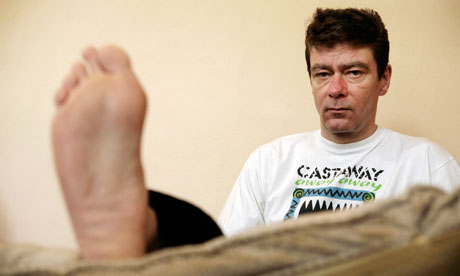
The attack came out of the blue and the pain was excruciating. Getting out of bed one morning, I placed my feet on the floor – and lurched headlong into the blanket box. My right big toe felt like it was being skewered by a pitchfork. Struggling back on to the bed, I saw that the toe and joint was swollen with a bright red sheen, and agonising to touch. Limping heavily (my wife had to steady me as I got dressed), I managed, with some effort, to manipulate my foot into a slipper.
My GP diagnosed gout. Like many people, I associated it with Henry VIII and rich living. Not quite. Gout – which comes on suddenly, over a few hours and often during the night – is determined by how well the body manages the breakdown and excretion through the kidneys of DNA protein, otherwise known as purines. If it can't control this, the purines break down to produce higher than normal levels of uric acid. These then build up and form crystals, which gather in a joint, causing inflammation and acute pain.
As many as one in 100 people will experience this at some point, rising to five in 100 for men aged 65 and over. And with people now living longer, these figures are likely to increase. It's an illness more common in men than in women, who tend to have lower levels of uric acid in their blood. It's also a condition that recurs. According to the British Medical Association, around 60% of sufferers will have a second attack within a year, more than 75% within two years, and over 80% within three years. "Incidents of gout are increasing and constitute the most acute inflammation for between 1-2% of men in the western world," says Dr Ian Rowe, a consultant rheumatologist.
Yet one of the difficult aspects of the illness for me is the assumption that it is brought on by rich living. Mention gout and people automatically assume that you gorge on rich food and down the booze in equal measure. Having limped in agony to the local shop, I mention the g-word and I am greeted by a smile and words along the lines of, "Too much of the good life, eh? You like your food and drink, eh?" And I have to put up with this whenever I explain my laboured gait.
It's true that GP's guidelines advise you to consider diet and lifestyle: moderate, or almost zero, consumption of purine-rich foods – red meat, liver, kidneys, shellfish – is recommended; and instead of red wine, stouts and spirits, I was told I should stick to a sensible intake of white wine and lager. Rowe says: "A healthy lifestyle is important. That means reducing consumption of alcohol and purine-rich foods and not going on a high-protein or crash diet."
So I couldn't help wondering if the occasional burger and bottle of red had actually been my undoing. But Richard Hull, consultant rheumatologist at Queen Alexandria hospital in Portsmouth, says not. "If my patients take their medication properly, I don't put too much emphasis on their eating habits," he says.
"Diet only affects up to 10% of purines, but of course, moderation is sensible. As for the benefits of drinking white wine, this is an old wives' tale. Consuming more than the recommended levels of alcohol does cause dehydration, which increases the likelihood of a gout attack." But the condition is also related to diabetes, kidney complaints, obesity and medications such as diuretics, or water tablets, for high blood pressure.
Even when you get treatment – usually anti-inflammatory drugs – it takes around a week to 10 days to work, and during this time the pain can be extremely disabling: lifting your foot to rest it on the sofa can cause agonising stabs. The preventative drug, allopurinol, can only be administered when the condition has calmed down, and has to be taken for the rest of your life as does the newly approved medication, febuxostat.
Since the first attack four years ago, my gout has returned annually and kept me company for a fortnight. I always keep my anti-inflammatory tablets to hand, because, despite my best efforts, I can't rule out another attack during the night.

